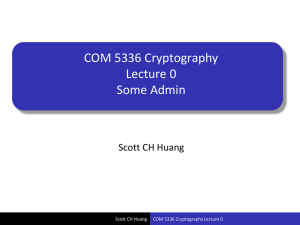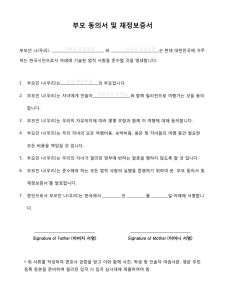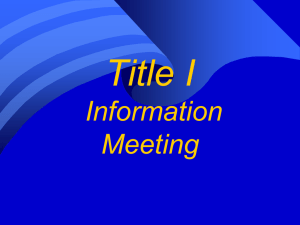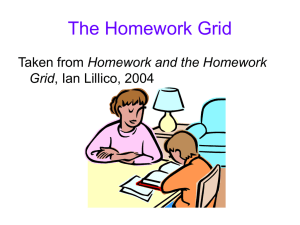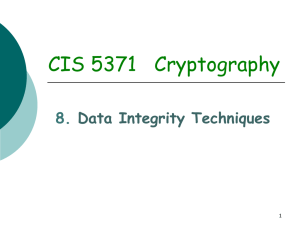M r
advertisement
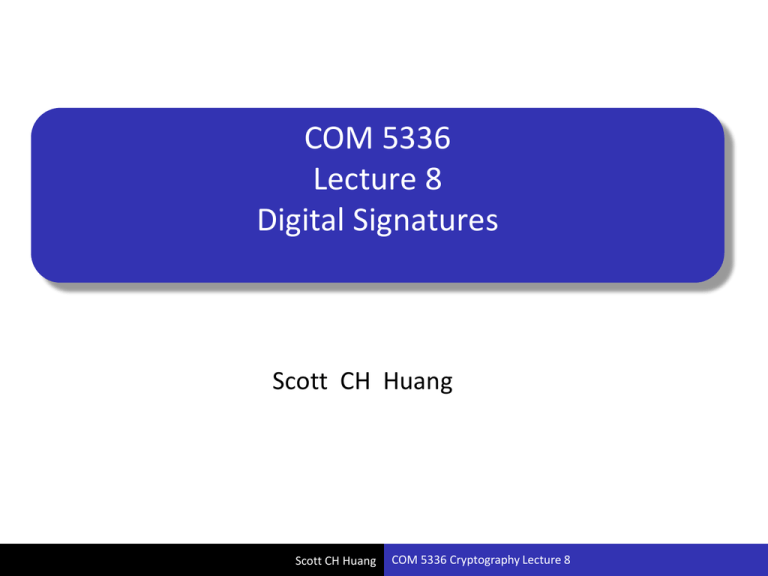
COM 5336
Lecture 8
Digital Signatures
Scott CH Huang
Scott CH Huang
COM 5336 Cryptography Lecture 8
Outline
•
•
•
•
•
•
•
Introduction
RSA signature scheme
ElGamal signature scheme
Rabin public-key signature scheme
DSA signature scheme (optional)
Rabin one-time signature
Arbitrated signature schemes
Scott CH Huang
COM 5336 Cryptography Lecture 8
Digital Signature
Scott CH Huang
COM 5336 Cryptography Lecture 8
Definitions
• Digital signature - a data string which associates a message
with some originating entity
• Digital signature generation algorithm – a method for
producing a digital signature
• Digital signature verification algorithm – a method for
verifying whether a digital signature is authentic
• Digital signature scheme - consists of a signature generation
algorithm and an associated verification algorithm
Scott CH Huang
COM 5336 Cryptography Lecture 8
Digital Signature
Digital Signatures can provide
• Authentication
• Data Integrity
• Non-Repudiation
• Timestamping
Scott CH Huang
COM 5336 Cryptography Lecture 8
Desirable Properties
• It should be efficient to compute by the signer
• It should be easy to verify by everybody
• It should be computationally infeasible for an attacker to
forge the signature
Scott CH Huang
COM 5336 Cryptography Lecture 8
Types of Digital Signatures
• Taxonomy of digital signatures
randomized
message recovery
deterministic
signature schemes
randomized
appendix
deterministic
Scott CH Huang
COM 5336 Cryptography Lecture 8
Schemes w/ Appendix
• Requires the message as input to verification algorithm
• Rely on cryptographic hash functions rather than customized
redundancy functions
• Schemes of this type
– ElGamal, DSA, Schnorr etc.
Scott CH Huang
COM 5336 Cryptography Lecture 8
Schemes w/ Message Recovery
• The original message is not required as input to the
verification algorithm
• The original message can be recovered from the signature
itself
• Schemes of this type
– RSA, Rabin, Nyberg-Rueppel
Scott CH Huang
COM 5336 Cryptography Lecture 8
Breaking a Signature Scheme
• Total Break: private key is comprimised
• Selective forgery: adversary can create a valid signature on a
preselected message
• Existential forgery: adversary can create a valid signature with
no control over the message
Scott CH Huang
COM 5336 Cryptography Lecture 8
Types of Attacks
• Key-only
– adversary knows only the public key
• Message attacks
– Known-message attack: adversary has signatures for a set of messages
which are known to the adversary but not chosen by him
– Chosen-message attack: adversary obtains valid signatures from a
chosen list of his choice (non adaptive)
– Adaptive chosen-message attack: adversary can use the signer as an
oracle
Scott CH Huang
COM 5336 Cryptography Lecture 8
RSA Signature Scheme
• Key generation n, p, q, e, d
• Sign
– Compute mr = R(m), where R is an invertable redundancy function that
maps a message into the signature space
– Compute s = mrd mod n
– The signature for m is s
• Verify
–
–
–
–
Obtain authentic public key (n, e)
Compute mr = se mod n
Verify that mr Mr
Recover m = R-1(mr)
Scott CH Huang
COM 5336 Cryptography Lecture 8
RSA Signature (cont’d)
• Attacks
– Integer factorization
– Homomorphic property
• Reblocking problem
– If signatures are encrypted different modulus sizes can render the
message unrecoverable
• Importance of the redundancy function
– ISO/IEC 9796
Scott CH Huang
COM 5336 Cryptography Lecture 8
RSA Signature (cont’d)
• Performance (p, q are k-bit primes)
– Signature O(k3)
– Verification O(k2)
• Bandwidth
– Bandwidth is determined by R. For example, ISO/IEC 9796 maps k-bit
messages to 2k-bit elements in MS for a 2k-bit signature (efficiency of ½)
Scott CH Huang
COM 5336 Cryptography Lecture 8
ElGamal Signature Scheme
•
•
Key generation: p, , a, y=a mod p
Signature Generation
–
–
–
–
–
Select random k, 1 k p-1, gcd(k, p-1)=1
Compute r = k mod p
Compute k-1 mod (p-1)
Compute s = k-1 (h(m) - ar) mod (p-1), where h is a one-way hash
function.
Signature is (r,s)
Scott CH Huang
COM 5336 Cryptography Lecture 8
ElGamal Signature (cont’d)
•
Signature Verification
–
–
–
–
Verify 1 r p-1
Compute v1 = yrrs mod p
Compute h(m) and v2= h(m) mod p
Accept iff v1=v2
s k 1{h(m) ar} (mod p 1)
ks h(m) ar (mod p 1)
h ( m ) ar ks ( a ) r r s (mod p )
Scott CH Huang
COM 5336 Cryptography Lecture 8
ElGamal Signature (cont’d)
•
Security (based on DLP)
–
–
–
Index-calculus attack: p should be large
Pohlig-Hellman attack: p-1 should not be smooth
Weak generators: If p 1 mod 4, |p-1, DL can be broken for
subgroup S of order . Forgeries are then possible
Scott CH Huang
COM 5336 Cryptography Lecture 8
ElGamal Signature (cont’d)
•
In addition…
–
–
k must be unique for each message signed
• (s1-s2)k=(h(m1)-h(m2))mod (p-1)
An existential forgery attack can be mounted if a hash function is not
used
Scott CH Huang
COM 5336 Cryptography Lecture 8
ElGamal Signature (cont’d)
•
Performance
–
–
•
Signature Generation
• One modular exponentiation
• One Euclidean Algorithm
• Both can be done offline
Verification
• Three modular exponentiations
Generalized ElGamal Signatures
Scott CH Huang
COM 5336 Cryptography Lecture 8
Rabin Public-Key Signature Scheme
• Signature: s = m1/2 mod n
– Using any sqrt
• Verification: m = s2 mod n
• About ¼ of the messages have sqrts.
• If a message doesn’t have a sqrt, then it has to be slightly
modified by doing proper padding.
Scott CH Huang
COM 5336 Cryptography Lecture 8
Rabin Signature (cont’d)
• In practice, one might try to append a small amount of
random bits and hope that it has a sqrt.
• On average, two such attempts would be enough.
• Such method has no guarantee of success, so a deterministic
method would be preferable.
Scott CH Huang
COM 5336 Cryptography Lecture 8
Modified Rabin Signature Scheme
• To overcome this problem, a modified Rabin signature
scheme is designed.
• It provides a deterministic method for associating messages
with elements in the signing space such that computing s
square root (or something close to it) is always possible.
• Details of modified Rabin signature scheme is beyond the
scope of this course.
Scott CH Huang
COM 5336 Cryptography Lecture 8
Rabin Signature Pros & Cons
• Advantage:
– Verification is extremely fast
– Cracking the signature scheme is provable as hard as doing
factorization.
• Disadvantage: like Rabin encryption, one system can only
generate signature for a single user.
Scott CH Huang
COM 5336 Cryptography Lecture 8
DSA Signature
•
DSA Algorithm : key generation
1.
2.
3.
4.
5.
select a prime q of 160 bits
Choose 0t8, select 2511+64t <p< 2512+64t with q|p-1
Select g in Zp*, and = g(p-1)/q mod p, 1 (ord()=q)
Select 1 a q-1, compute y= a mod p
public key (p,q, ,y), private key a
Scott CH Huang
COM 5336 Cryptography Lecture 8
DSA Signature (cont’d)
•
DSA signature generation
–
–
–
–
–
Select a random integer k, 0 < k < q
Compute r=(k mod p) mod q
Compute k-1 mod q
Compute s=k-1 (h(m) + ar) mod q
Signature = (r, s)
Scott CH Huang
COM 5336 Cryptography Lecture 8
DSA Signature (cont’d)
•
DSA signature verification
–
–
–
–
–
Verify 0<r<q and 0<s<q, if not, invalid
Compute w= s-1mod q
Compute u1=wh(m) mod q, u2=rw mod q
Compute v = (u1yu2 mod p) mod q
Valid iff v=r
h(m) ar ks (mod q)
wh(m) arw k (mod q)
u1 au2 k (mod q)
u1 y u2 mod p(mod q) k mod p(mod q)
Scott CH Huang
COM 5336 Cryptography Lecture 8
DSA Signature (cont’d)
•
Security of DSA
–
•
Parameters:
–
•
two distinct DL problems: ZP*, cyclic subgroup order q
q~160bits, p 768~1Kb, p,q, can be system wide
Probability of failure
–
Pr[s=0]= (1/2)160
Scott CH Huang
COM 5336 Cryptography Lecture 8
DSA Signature (cont’d)
•
Performance
–
Signature Generation
• One modular exponentiation
• Several 160-bit operations (if p is 768 bits)
• The exponentiation can be pre-computed
– Verification
•
Two modular exponentiations
Scott CH Huang
COM 5336 Cryptography Lecture 8
Nyberg-Rueppel Signature Scheme
• Can be regarded as an ElGamal signature scheme w/ message
recovery
• Key generation:
– Same as DSA but no constraints on the sizes of p,q
– Select g in Zp*, and = g(p-1)/q mod p, 1 (ord()=q)
– Select, p,q w/ q|(p-1}, Zp*, (private key) a, y= a.
Scott CH Huang
COM 5336 Cryptography Lecture 8
Nyberg-Rueppel Signature Scheme
• Sign message m
–
–
–
–
Compute mr = R(m), where R is an invertable redundancy function
Select a random secret integer k s.t. 1 k p-1
Compute r -k (mod p), e mr r (mod p), and s ae + k (mod q)
Signature is (e,s)
• Verify signature (e,s)
–
–
–
–
Obtain authentic public key (p,q, ,y)
Verify that 0 < e < p and 0 s q. If not, reject.
Compute v sy-e (mod p) and m ve (mod p)
Recover m = R-1(mr)
Scott CH Huang
COM 5336 Cryptography Lecture 8
